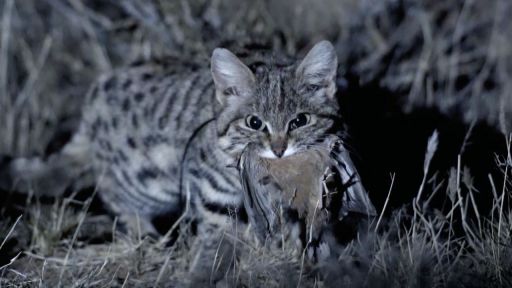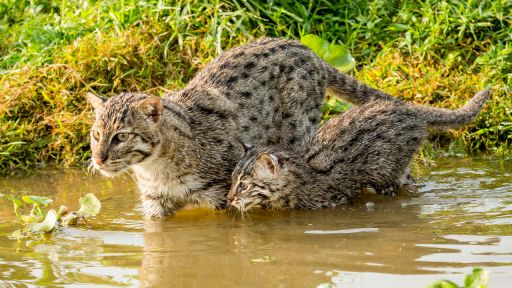In part two of NATURE’s miniseries “Super Cats,” discover how cats have conquered the world, thriving in almost every landscape on Earth. In the wetlands of Asia, fishing cats have adapted to an aquatic lifestyle. In the world’s oldest desert, Africa’s youngest lion pride survives against the odds. A military-grade thermal camera in Costa Rica peers into the dark to find a pregnant jaguar waiting for turtles on a tropical beach. High in the forest of Central America, a female margay leaps from tree to tree, slow-motion footage revealing her acrobatic skills. In California, a bobcat, blind in one eye, seizes an opportunity to hunt gulls on a secluded beach. At low tide in the Sundarbans of India and Bangladesh, a rarely seen swamp tiger emerges from the mangrove forest to patrol his shorelines. Then there’s Africa’s black-footed cat, the smallest and deadliest of all.
Super Cats: Episode 2 | Cats in Every Corner
Discover how cats have conquered the world, thriving in almost every landscape on Earth, from the wetlands of Asia to Africa's oldest desert, to the shores of California and the tropical beaches of Costa Rica.
Features
Narrated by
F. MURRAY ABRAHAM
Produced & Directed by
PAUL WILLIAMS
Photography
SUE GIBSON
LUKE BARNETT
HOWARD BOURNE
LIANNE STEENKAMP
KALYAN VARMA
KENNAN WARD
Additional Photography
NEIL ANDERSON
DOUGLAS PARKER
ALONSO SANCHEZ ESPINOZA
WILL STEENKAMP
Film Editor
SAM ROGERS
Assistant Film Editor
JACK ROBERTS
Post Production
DOGHOUSE POST PRODUCTION
WOUNDED BUFFALO
Graphic Design
BDH CREATIVE
Sound Editor
TIM OWENS
Dubbing Mixer
BEN PEACE
Colorist
FRED TAY
Online Editor
MICHAEL LANSDELL
Original Music
BLEEDING FINGERS
Score Producers
MONICA SONAND
RUSSELL EMANUEL
Scientific Consultants
Dr ALEXANDER SLIWA
Dr LUKE HUNTER
Special Thanks:
EVIE ADAMS
JANE ATKINS
MATT RICHARDS
SERGIO ESCOBAR-LASSO
BLACK-FOOTED CAT WORKING GROUP
GOINGWILD LLP
SECUNDA SYNFUELS OPERATIONS / SASOL LTD.
Logistics Support
DR BARIUSHAA MUNKHTSOG
RICHARD FOSTER
BIOCENOSIS MARINA LIMITADA
THE BELIZE ZOO AND TROPICAL EDUCATION CENTER
Wildlife Permits Provided by
MINISTRY OF ENVIRONMENT AND FORESTS, INDIA
WILDLIFE TRUST OF INDIA
Directors
SARA DOUGLAS
ANNA PLACE
Researcher
HARRIET LAWRENCE
Production Coordinators
JO ARMSTRONG DAVIS
ELLIE WILLIAMS
Production Management Assistant
SUSANNA PROUSE
Production Manager
STELLA STYLIANOS
Unit Manager
KATE GORST
Commissioning Editor
TOM MCDONALD
Series Producer
GAVIN BOYLAND
Executive Producer
MICHAEL GUNTON
For NATURE
Series Editor
JANET HESS
Senior Producer
LAURA METZGER LYNCH
Coordinating Producer
JAYNE JUN
Associate Producer
JAMES F. BURKE
Legal Counsel
BLANCHE ROBERTSON
Digital Producer
HEATHER TONER
Social Media Editor
WHITNEY MCGOWAN
Audience Engagement
CHELSEY SAATKAMP
Budget Controller
JAYNE LISI
Online Editor
STACEY DOUGLASS MOVERLEY
Re-Recording Mixer
ED CAMPBELL
Original Funding Provided in Part by
The Arnhold Family In Memory Of Clarisse Arnhold
Sue and Edgar Wachenheim III
Kate W. Cassidy Foundation
Lillian Goldman Charitable Trust
Kathy Chiao and Ken Hao
Anderson Family Fund
Filomen M. D’Agostino Foundation
Rosalind P. Walter
The Halmi Family in memory of Robert Halmi, Sr.
Sandra Atlas Bass
The Arlene and Milton D. Berkman Philanthropic Fund
Anne Ray foundation
Corporation for Public Broadcasting
Series Producer
BILL MURPHY
Executive Producer
FRED KAUFMAN
A BBC Studios Production for PBS and BBC with THIRTEEN Productions LLC, co-produced by France Télévisions
This program was produced by THIRTEEN Productions LLC, which is solely responsible for its content
© 2018 BBC
SUPER CATS ADDITIONAL MATERIALS © 2018 PBS AND
© 2018 THIRTEEN PRODUCTIONS LLC
ALL RIGHTS RESERVED
NATURE's three-part series continues.
From the oldest desert in Africa to the highest mountain on earth, cats are leading extraordinary lives.
They are acrobats in the jungle and opportunists on the beach.
Big or small, cats have conquered the planet.


